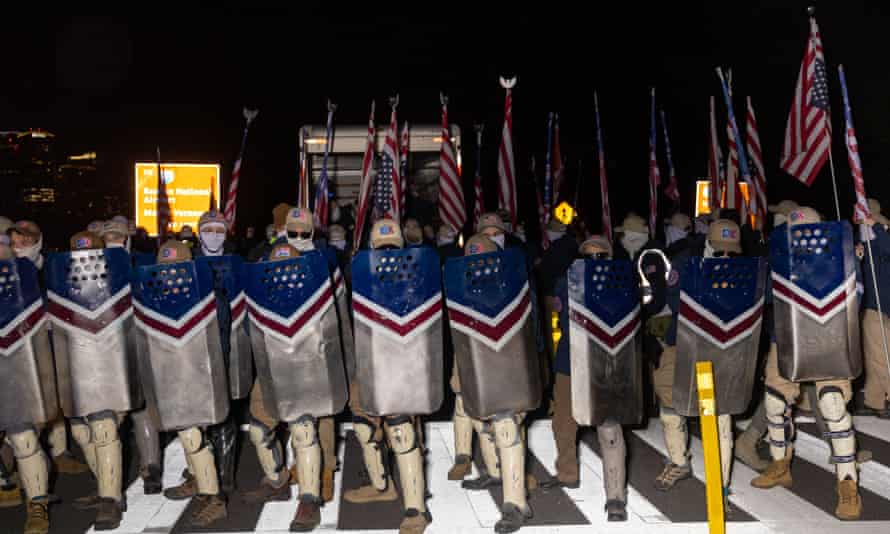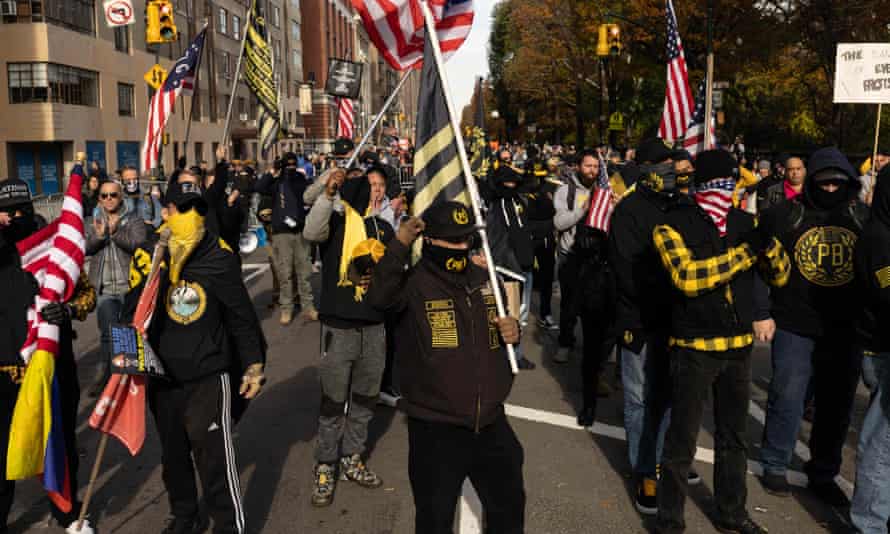TThat month, more than 100 members of a white supremacy group called the Patriot Front marched with shields and American flags at the Lincoln Memorial in Washington DC to bring strength to a national stage.
The stormtrooper-like appearance of a phalanx of members of the group trudging through the streets of the American capital seemed shocking and made headlines, even if it ended in a farce.
But the Patriot Front’s action actually refuted a disturbing reality of how many American far-right groups have shifted their focus in 2021 to far more local audiences and regional venues, where, experts warn, their activities can have far-reaching and dangerous implications.
In the wake of the January 6 attack on the Capitol, US law enforcement has hit right-wing groups like the Proud Boys and the Oath Keepers hard. Large tech companies have also severely constrained their ability to get their message across, with widespread losing platform membership on popular social networks.
However, extremism experts say that the extreme right in America is currently going through a kind of atomization and localization: away from centralized organizations, which may be subject to greater surveillance by federal law, and towards decentralized movements in regional places where they can and actually seek official positions take power.
National right-wing extremist groups with state chapters, such as the Proud Boys and Oath Keepers, have disbanded the national leadership and split it into state and domestic groups. “After January 6, many organizational and leadership vacuums opened,” said Jared Holt, a local extremism researcher at the Atlantic Council’s Digital Forensic Research Lab.
 Members of the Patriot Front hide behind shields in Washington DC. Photo: REX / Shutterstock
Members of the Patriot Front hide behind shields in Washington DC. Photo: REX / Shutterstock
“Much of this effort to decentralize these organizations and move them to local venues is being voiced by leaders at these moments, hoping to bypass law enforcement and public scrutiny and create a more resilient GOP influence from the ground up create. “Said Holt.
This new iteration of the extreme right has also taken numerous forms. Groups like the Proud Boys and Oath Keepers are the best known, but not the only manifestations of right-wing extremist activity. For example, researchers at the University of Chicago found that 89% of the rioters who stormed the Capitol on Jan. 6 were not members of any gang or militia group. Many are lonely extremists, drawn to an archipelago that ranges from electoral conspiracies to anti-Vaxx movements to opposition to racism education in schools.
Much of the new far-right activity challenging local democracy does not take the form of men with guns storming buildings. But its goals are similar: the machinery of American democracy. And that activity is picking up after Donald Trump’s allegations of stolen elections in 2020 and the acceptance of this “big lie” by much of Conservative America.
In Colorado, election fraud conspirators were charged with breaking into voting machines and threatening officials for refusing to accept the theft of the 2020 election. The individuals involved were a strong example of various elements of the right and the far right: a Republican district official, a member of the Three Percenter militia, a QAnon influencer.
But taken together there is a clear correlation of how the different groups form a movement.
Colorado Foreign Secretary Jena Griswold said that a warehouse in rural Mesa County that stores the county’s elective equipment was broken into after security cameras were deliberately turned off. The target of the break-in were Dominion voting machines. Copied hard drives from the machines and the passwords of the voting system then ended up in the hands of Ron Watkins, a prominent QAnon conspiracy theorist. Watkins published the passwords of the voting machines online to prove that the machines could be easily tampered with.
According to Griswold, investigators suspected the violation was orchestrated by Tina Peters, the Republican elected officer responsible for the integrity of the Mesa district elections.
Peters, speaking on social media about the 2020 theft, refused to cooperate with investigators. In August, Peters flew to South Dakota while the prosecutor was raiding her office and decided to speak at the Election Conspiracy Symposium held by Mike Lindell, My Pillow CEO and ardent Trump supporter. The FBI has since ransacked Peters’ apartment and a judge has revoked her authority to monitor elections while the investigation continues.
In December, Peters appeared at a Zoom meeting with district commissioners along with a man associated with the three percent militia who criticized the commissioners and law enforcement as “weak” before wearing the three percent symbol with his Fingers flashed. In the same conversation, Shawn Smith, a retired Air Force colonel, warned commissioners of the impending violence from people like him who would not accept a tyrannical government. “It’s going to be very dangerous,” he warned.
The threats prompted the local sheriff to announce that they are considering increasing security for the district officials. But the intimidation wasn’t limited to local officials. That same month, Colorado Secretary of State Griswold took the unprecedented step of soliciting lawmakers for $ 200,000 annually on security guards to combat the mounting death threats. Colorado follows a nationwide wave of threats against election officials.
The bottom-up strategy has been widely promoted by prominent far-right figures such as former top Trump adviser Steve Bannon, who have articulated to regain control of the country “district by district”. The strategy that was strongly promoted in Bannon’s podcast has prevailed.
People’s Rights, an anti-government group founded by the right-wing militia figure Ammon Bundy, operates as independent cells in each state and focuses exclusively on building regional coalitions. An Idaho cell organizer posted a message on its website in November highlighting the postponement: “No more protests in the Capitol. It will not work. You beat them in their county offices, in their neighborhoods … Think about the local government. “
The local shift has resulted in the Proud Boys returning to mainstream conservative circles. The far-right thugs have found a role as a kind of muscle between the various conservative suburban movements from anti-critical racial theory to Covid conspiracies.
 Members of the Proud Boys protest in New York in November. Photo: Yuki Iwamura / AFP / Getty Images
Members of the Proud Boys protest in New York in November. Photo: Yuki Iwamura / AFP / Getty Images
Holt says the Proud Boys strategically offer themselves as a more extremist element in the kind of suburban affairs conservatives care about. “They are integrating into more established political circles … Part of the strategy is to go into these local arenas like school boards,” said Holt.
In November, Proud Boys in Downers Groove, Illionis, attended a suburban school board meeting to help more established Conservatives in efforts to ban genderqueer books in schools. That month, Proud Boys appeared in similar roles in school board meetings in North Carolina, Oregon, Florida, Wisconsin, and New Hampshire.
In September, three schools in Vancouver, Washington, were closed after a group of Proud Boys “escorted” a student who refused to do a mask job on school grounds to ensure he could attend class.
In August, the Proud Boys, along with a constellation of thugs associated with other right-wing extremist movements, provided informal security for a controversial religious event hosted by Sean Feucht in Portland, Oregon. Fuecht organizes maskless concerts in cities where Black Lives Matter demonstrations were frequent.
That night, the Proud Boys closed an intersection in downtown Portland and distracted cars from an exit they had set up for concert-goers. When anti-fascists arrived for the counter-demonstration, the two groups clashed in open confrontation for almost an hour. The two groups swap bear butts, paintball balls and fireworks without any reaction from the police.
Holt says groups like the Proud Boys are taking advantage of smaller jurisdictions with sometimes friendlier law enforcement agencies to test a return to overt violence.
“At the national level, there have been many updates to law enforcement, updating their definition and understanding of the far right threat after January 6th.” says Holt: “But at the local level there is less direct supervision of how these departments work, and there is a great deal of variation in their own knowledge of these groups.”
The result is a kind of stress test for local governments in the US as more and more extremist tactics invade civic life.
This month, Northern Virginia fire department marshals and sheriff deputies were dispatched to a Spotsylvania County suburban school committee meeting to act as a deterrent against a supposedly online book-burning rally. The Washington DC suburb had attracted attention after its school board voted to ban sexually explicit books and two school board members went so far as to publicly consider burning them.
School authorities lifted the book ban a week later, but not before the rhetoric inspired a seedy local Facebook page to promote a book burn in the school parking lot.
“We got caught on the Facebook post, we’re not telling people how to exercise their first rights of amendment, but you can’t burn property on someone else’s property,” said Steve Cooper, assistant firefighter for Spotsylvania County.
The post was later dismantled and no one turned up to burn books, but the mere threat changed the everyday world in terrible words. “Most of this has never happened,” said Rich Liberman, a local parent and 36-year-old local resident. “School board meetings are supposed to be boring.”


